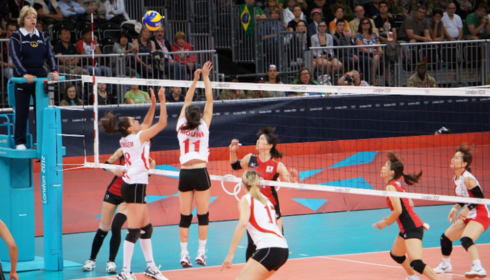Choosing the right volleyball court flooring is essential to ensure safety, performance, and longevity—whether you’re building an indoor arena or an outdoor recreational setup. The type of flooring used directly impacts ball bounce, player movement, and maintenance needs. From schools and colleges to clubs and training centers, having a clear understanding of your flooring options can help you make a cost-effective and durable choice.
This guide covers the most popular volleyball court flooring material options, their pros and cons, cost ranges, and recommendations tailored to the Indian climate and usage patterns.
Why Volleyball Court Flooring Matters
Volleyball involves constant jumping, sliding, and rapid footwork. The flooring must absorb impact, provide sufficient grip, and resist wear over time. Poor-quality flooring can lead to injuries, inconsistent play, and high repair costs.
A good volleyball court material should:
- Offer slip resistance and shock absorption
- Withstand high foot traffic
- Be weather-resistant (for outdoor use)
- Require low maintenance
- Be cost-efficient in the long term
Types of Volleyball Court Flooring
Let’s explore the key volleyball court flooring types, both for indoor and outdoor applications.
1. PU Sports Flooring (Indoor)
PU (Polyurethane) flooring is a seamless, high-performance surface commonly used in professional indoor volleyball courts.
- Features:
- Excellent shock absorption and player comfort
- Durable and seamless surface
- Easy to clean and maintain
- Excellent shock absorption and player comfort
- Applications: Professional training centers, indoor stadiums
- Cost: ₹700 – ₹1200 per sq. meter
Pros:
- Long lifespan
- Seamless aesthetics
- High ball rebound and consistent grip
Cons:
- Higher initial cost
- Requires skilled installation
2. Vinyl Sports Flooring (Indoor)
Vinyl flooring is widely used in school and club-level volleyball courts. It comes in rolls or tiles and offers decent shock absorption at a lower cost.
- Features:
- Anti-skid surface
- Available in different thicknesses (typically 4.5 mm to 7 mm)
- Easy replacement of damaged sections
- Anti-skid surface
- Applications: School courts, multipurpose indoor halls
- Cost: ₹450 – ₹850 per sq. meter
Pros:
- Cost-effective
- Available in various colors and finishes
- Moderate durability
Cons:
- Not suitable for high-performance or competitive games
- Can fade or peel over time if poorly maintained
3. Synthetic Acrylic Flooring (Outdoor)
Synthetic acrylic flooring is the most commonly used surface for outdoor volleyball court flooring in India due to its affordability and weather resistance.
- Features:
- UV-stable and anti-slip surface
- Applied as a multi-layer coating over concrete
- Available in custom colors
- UV-stable and anti-slip surface
- Applications: Housing societies, school play areas, community parks
- Cost: ₹350 – ₹600 per sq. meter
Pros:
- Low maintenance
- Good for Indian climate
- Quick application process
Cons:
- Not cushioned; harder surface
- Requires a well-prepared concrete base
4. Modular Interlocking Tiles (Indoor & Outdoor)
Modular tiles are made of high-impact polypropylene and offer portability and flexibility. They’re especially useful in locations where courts need to be assembled or moved frequently.
- Features:
- Weatherproof and water-drainable design
- Easy to install and uninstall
- Available in textured finishes for better grip
- Weatherproof and water-drainable design
- Applications: Temporary courts, community centers, rooftop courts
- Cost: ₹450 – ₹750 per sq. meter
Pros:
- Reusable and low-maintenance
- Quick installation
- Suitable for both indoor and outdoor use
Cons:
- Slight joint lines may affect ball bounce
- Less shock absorption than PU or vinyl
Volleyball Court Flooring Price Comparison
| Flooring Type | Indoor/Outdoor | Estimated Cost (₹/sq. m) | Best For |
| PU Sports Flooring | Indoor | 700 – 1200 | Pro-level training, academies |
| Vinyl Sports Flooring | Indoor | 450 – 850 | Schools, multipurpose halls |
| Synthetic Acrylic | Outdoor | 350 – 600 | School & public outdoor courts |
| Modular Interlocking | Both | 450 – 750 | Temporary or portable courts |
Choosing the Right Volleyball Court Material
When selecting a volleyball court flooring material, consider the following:
1. Player Demographics
- Competitive use: Go for PU or thicker vinyl for better performance and injury prevention.
- Casual or school use: Acrylic or modular tiles can work well within budget.
2. Climate Conditions
- For outdoor courts in hot or rainy climates, synthetic acrylic or modular tiles are ideal due to their UV resistance and water drainage capacity.
3. Budget Constraints
- PU and vinyl cost more upfront but offer better longevity for indoor courts.
- Acrylic and modular tiles are more affordable and easier to maintain outdoors.
4. Usage Frequency
- Heavy usage demands a durable surface like PU.
- Light or occasional use can be managed with modular tiles or acrylic.
Working with a Volleyball Court Flooring Company
To get the best results, it’s important to partner with a trusted volleyball court flooring company. Here’s what to look for:
- Expertise in sports surfaces
- Customized layout and dimensions
- Proper base preparation and installation
- Warranty on materials and labor
- After-sales support and maintenance guidance
Reputable companies also ensure that the materials comply with international standards like FIVB (Fédération Internationale de Volleyball), especially if you’re building a tournament-grade court.
Conclusion
Investing in the right volleyball court flooring can drastically improve player performance, safety, and court longevity. While PU sports flooring is ideal for professional indoor use, vinyl flooring offers a good balance for schools and community setups. For outdoor volleyball courts, synthetic acrylic remains the most cost-effective and weather-resistant option. Modular tiles, on the other hand, are perfect for portable or temporary court needs.
With the right planning and materials, your volleyball court can remain functional, attractive, and low-maintenance for years. Choose wisely, and always work with experienced flooring specialists to ensure lasting quality.



